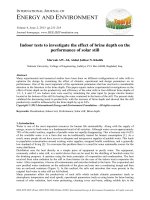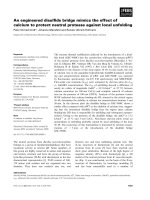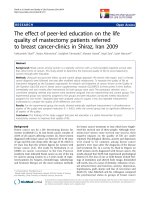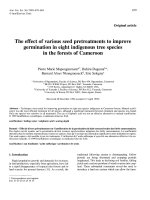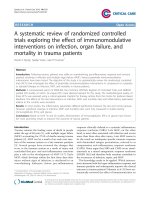Exploring the effect of cathodic polarization to mitigate CRUD deposition
Bạn đang xem bản rút gọn của tài liệu. Xem và tải ngay bản đầy đủ của tài liệu tại đây (2.72 MB, 6 trang )
Nuclear Engineering and Design 366 (2020) 110764
Contents lists available at ScienceDirect
Nuclear Engineering and Design
journal homepage: www.elsevier.com/locate/nucengdes
Exploring the effect of cathodic polarization to mitigate CRUD deposition
a
a
b
Stefano Cassineri , Michele Curioni , Andrew Banks , Fabio Scenini
a
b
a,⁎
T
Materials Performance Centre, Department of Materials, Universtiy of Manchester, Oxford Road, M13 9PL Manchester, United Kingdom
Rolls Royce plc, Kings Place, 90 York Way, N1 9FX London, United Kingdom
A R T I C LE I N FO
A B S T R A C T
Keywords:
Micro-orifices
Cathodic polarization
PWR
CRUD mitigation
Hydrogen evolution
Electrokinetic deposition
Cathodic polarization is investigated as a technique for CRUD build-up mitigation in simulated primary pressurized water reactor conditions and accelerated flow. This investigation showed that the application of 3 V
could induce a 67% reduction in surface deposition whilst 30 V cell voltage completely prevented the formation
of surface deposits. This behavior can be rationalized considering the synergistic effect between the suppression
of the electrokinetic component responsible for the CRUD build-up, and the hydrodynamic cleaning arising from
the hydrogen evolution on the cathodically polarized surface.
1. Introduction
Corrosion product build-up in the primary cycle of the pressurized
water reactor is known under the acronym CRUD. Such corrosion
products are well known to compromise the safety and economic
profitability of nuclear power plants (Uchida et al., 2011). For instance,
Co-59 can transmute to Co-60 and increases the radiation levels within
the primary cooling circuit when incorporated in the oxide (Holdsworth
et al., 2018), whilst corrosion product build-up on the steam generator
and fuel rods reduces the overall thermohydraulic performance (Uchida
et al., 2011).
CRUD build-up under the accelerated flow conditions observed in
the steam generator is believed to be driven by electrokinetic activity
across the metal solution interface (Cassineri et al., 2020b,a, 2019a,b;
McGrady et al., 2017a,b; Scenini et al., 2014; Yang et al., 2017). Specifically, electrokinetic deposition of CRUD is driven by the acceleration
of the flow when the zeta potential of the metal is negative, and the
streaming current generated is positive (Cassineri et al., 2019c,a). In
this situation the local unbalance of charges originating from the accelerated flow conditions is compensated by the generation of faradaic
reactions across the metal/solution interface, resulting in the oxidation
of soluble Fe2+ to insoluble Fe3+, followed by the deposition of magnetite (Cassineri et al., 2019c,a, 2020a; McGrady et al., 2017a; Scenini
et al., 2014).
Currently, there are no preventive or mitigating in-service methods
to deal with the CRUD formation, which is removed, at a high economic
cost, after shutdown, through chemical and hydrodynamic treatment
(Fujiwara et al., 2004; Szolcek et al., 2019; Vepsalainen, 2010). Thus,
the necessity to find an effective method to mitigate CRUD deposition
⁎
without requiring the power plant to shutdown is highly desirable. In
the oil and gas industry and in the civil sector, the application of
cathodic protection is well established as a technique used to protect
submerged pipelines and reinforced concrete structures against localised and uniform corrosion (Pedeferri, 1996).
In this work, as a proof of concept, cathodic polarization is investigated as a possible technique for CRUD build up mitigation in
accelerated flow regions in high temperature water, conditions that are
relevant to primary PWR operation. Tests were conducted in an autoclave at a temperature of 230 °C, pressure 120 bar and at Li and H2
content respectively of 2 ppm and 2.5 ppm. Boric acid is usually added
to primary water of commercial PWRs to control reactivity and its
concentration is reduced towards the end of the fuel cycle. For consistency with previous work (Cassineri et al., 2019a), and to enable
comparison of the results, boric acid was not added in the present study.
However, it is believed that the higher pH in the present work, compared to when boric acid is added, would not have a significant effect
on the CRUD deposition mechanism. The polarization tests were performed using an in-house designed flow cell that contains a micro-orifice specimen that was cathodically polarized.
2. Experimental details
The tests were carried out in a 13-liter autoclave SS316 vessel
schematically shown in Fig. 1 and extensively described in previous
work carried out by the authors (Cassineri et al., 2019a c; Cioncolini
et al., 2017; McGrady et al., 2017a,b). The driving force required to
move the water through the system was imposed by a volumetric pump
able to deliver a flow rate of up to 35 l/h. After being pre-heated to
Corresponding author.
E-mail address: (F. Scenini).
/>Received 19 February 2020; Received in revised form 7 July 2020; Accepted 9 July 2020
Available online 18 July 2020
0029-5493/ © 2020 The Authors. Published by Elsevier B.V. This is an open access article under the CC BY license
( />
Nuclear Engineering and Design 366 (2020) 110764
S. Cassineri, et al.
Fig. 1. Schematic representation of the flow loop used for the polarization experiments. Image adapted from (McGrady et al., 2017a).
Fig. 2. Flow cells used in the polarization tests: a) optical image of the flow cells used in the polarization tests b) 3D CAD of the polarization cell showing from bottom
to top the female face sealing, the copper gasket, the micro-orifice, the male face sealing, the two copper washers, and the stainless steel rod screwed inside the PTFE
cylinder, c) cross-section schematic of the cell.
back pressure regulators which set the pressure drop across the microorifice (Cassineri et al., 2019a,c; McGrady et al., 2017a,b). The accurate
control and monitoring of the water chemistry was achieved through
oxygen (Orbisphere 410/A/P1C00000), hydrogen (Orbisphere
510B00/T1C0P000) and conductivity sensors (ABB AX410/500001).
The pressure drop across the flow cell was measured using a differential
pressure cell Rosemount (model C2051CD, ± 20.7 bar, 0.075% full-
230 °C, the water was injected inside the autoclave, and after passing
through the flow cells, the water was cooled, depressurized, recirculated through a mixed bed of ion exchange resin and re-injected to
the 250-liter storage feed tank. The tests were carried out at constant
pressure drop which corresponds to constant flow velocity in the troat
of the orifice even when it is partly clogged (Cassineri et al., 2019a,c;
McGrady et al., 2017a,b); this was achieved thanks to the use of two
2
Nuclear Engineering and Design 366 (2020) 110764
S. Cassineri, et al.
Table 1
Experimental test matrix.
Disc tested*
Lithium/ppm
Hydrogen/ppm
Applied Cell potential/V
Diameter/µm
Time/h
D400-0 V
D400-1 V
D400-3 V
D400-30 V
2
2.5
0
1
3
30
400
24
23.5
* The nomenclature of the disc is: Diameter (µm)-Cell potential applied (V).
Fig. 3. Hydrodynamic measurements showing a) the evolution of the diameter and b) the flow velocity across the test over time.
connection of the anode was achieved by spot welding the SS rod to a
nickel–chromium wire (Ni80/Cr20) that was PTFE sleeved. The disc
was electrically connected to the autoclave flow loop and therefore no
special electrical connection was required.
Three cell potentials (1, 3 and 30 V) were applied between the SS
rod and the flow cell. 1 and 3 V cell potentials were achieved with the
potentiostat using a two-electrode configuration, while the 30 V cell
potential was applied with the power supply. A control CRUD build-up
test, using the identical setup of the other flow cells but without polarization, was carried out and used a reference. It is worth noting that
this investigation represents a proof of concept rather than a comprehensive study aiming at mechanicstic understanding; as such, the test
domain (1–30 V) was selected to cover a broad range of applied currents that were theoretically calculated to be in the range of ≈20 to
550 µA. The highest voltage was selected to counteract the low cathodic
polarization efficiency associated with the high electrolyte resistance
(Roychowdhury et al., 2016). During the test, the effective current was
recorded by the potentiostat when the voltages applied between the
micro-orifice and the SS rod were 1 and 3 V. No electrical current was
recorded when the applied voltage was the highest (30 V).
All the experiments were carried out at 230 °C, 120 bar, 2 ppm of Li
and 2.5 ppm of H2 and the flow velocity was maintained constant
≈35 m/s inside the micro-orifice. The operating temperature of 230 °C
was selected due to experimental limitations and taking into consideration the requirements to operate under single-phase flow conditions. These conditions represented the compromise between the requirements of fixing the outlet pressure at 120 bar, i.e. well above the
vapour pressure of water at 230 °C, and the safety requirement to limit
the upstream pressure of the autoclave to a maximum value of 200 bar,
i.e. the sum of the outlet pressure and the pressure drop across the
micro-orifice. Conversely, the flow velocity value of 35 m/s was selected to induce a relatively fast deposition rate but also to avoid the
mechanical removal caused by erosion (Cassineri et al., 2019a).
Scanning Electron Microscopy SEM and Laser Confocal Microscopy
were carried out with a FEG-SEM Zeiss Sigma and Keyence VK-X200K
Table 2
CRUD build-up estimated via laser confocal analysis.
D400-0 V
D400-1 V
D400-3 V
D400-30 V
Applied Cell potential/V
Volume/µm3
0
1
3
30
662,741
654,558
216,463
0
scale accuracy) and the mass flow rate was measured using two variable
area digital flow meters (Swagelok model VAF-M2, 0–1.4 cm3 s−1 and
1.1–11.1 cm3 s−1 spans) appositely calibrated prior to the tests (accuracy within 1%). Polarization tests were carried out using either a potentiostat (Gamry-reference 600) or a DC power supply (Skytronic
0–3A, 0–30 V) depending on the cell potential applied between a
Stainless-steel rod (anode) and the micro-orifice specimens (cathode).
The micro-orifices were 1 mm thick and 11.7 mm wide and were
manufactured from SS304L with a mechanically drilled 400 µm microorifice. Before the tests, the flow entry side and the flow exit side of the
discs were ground up to 600 grit using a Si-C emery paper. Prior to the
test, the samples were pre-oxidised for 24 h at 230 °C in lithiated and
hydrogenated water. Although this short oxidation time it is not sufficient to form a fully developed oxide layer, it is also known that on the
stainless-steel discs, in slightly alkaline (lithiated) and hydrogenated
water, the zeta potential of magnetite is negative. Thus, a variation of
the oxide thickness is not expected to impact significantly on the zeta
potential (Hunter, 1988). The micro-orifice was accommodated in an
in-house made flow cell where the sealing between the flow cell and the
micro-orifice was achieved with a 1 mm thick copper washer. The
anode was a threaded 304SS rod, 6 cm long and with a diameter of
3 mm that was screwed in the centre of a PTFE cylinder and placed at a
distance of 2 mm from the micro-orifice surface as shown in Fig. 2.
Eight holes with a diameter of 1.5 mm were mechanically drilled
around the anode to allow the water to flow between the surface of the
anode (threaded rod) and the cathode (micro-orifice). The electrical
3
Nuclear Engineering and Design 366 (2020) 110764
S. Cassineri, et al.
Fig. 4. CRUD volume calculated from laser confocal analysis vs. the applied potential investigated (1, 3 and 30 V).
which, for passive metals like stainless steels and Ni base alloys, corresponds to the reverse H+/H2 Nernst potential (Volpe et al., 2019). In
the absence of cathodic polarization, the anodic reaction is the sum of
the passive oxide film formation and the formation of CRUD deposition,
where the latter is the dominant one; in fact, the steady state thickness
of the oxide in PWR water is expected to be less than ~1 µm after 500 h
exposure (Chang et al., 2018), whilst the CRUD deposition rate shown
in this work is several microns after 24 h (Fig. 5). These anodic reactions are supported by a cathodic reaction which is hydrogen evolution
reaction (Birkin et al., 2015; Taqieddin et al., 2017); in fact, recalling
that dissolved oxygen in PWR primary water is below 5 ppb, the
cathodic oxygen reduction reaction is negligible. However, during
cathodic polarization this equilibrium is shifted and the surface, which
is polarized more negatively, will become a dominant cathode whilst
the anodic reaction is suppressed. The complete suppression of CRUD
deposition during cathodic polarization can be ascribed to two concurring phenomena. Firstly, the hydrogen evolved on the cathodic polarized surface can potentially promote the hydrodynamic removal of
the deposited oxide. In fact, atomic and molecular hydrogen are currently used for the removal of carbon contamination in semiconductor
and, as a result of the cathodic charging, in the electrochemical
cleaning of Al alloys (Aßmuth et al., 2007; De Graeve and Terryn,
2000). Secondly, CRUD deposition under accelerated flow conditions
and alkaline pH (2 ppm of Li and 2.5 ppm of H2) was found to be driven
by electrokinetic activity (Cassineri et al., 2019c,a; McGrady et al.,
2017a,b; Szolcek et al., 2019). The electrokinetic activity was associated with the occurrence of Faradaic reactions responsible for the
oxidation of Fe2+ to Fe3+ followed by the deposition of magnetite. The
hypothesis of this work is that the established reducing conditions,
achieved through cathodic polarization, will counteract the electrokinetic effect by inhibiting the oxidation of ferrous to ferric iron, thus
preventing the deposition of the compact and tenacious magnetite
oxide (Cassineri et al., 2019a) layer. In Fig. 5 the compact and crystalline layers arising from electrokinetic activity are not directly visible
due to the coverage caused by the particulate build-up. However, the
deposition symmetry observed in Fig. 5-e and f is consistent with the
CRUD structure observed in previous work (Cassineri et al., 2019c) thus
3D microscope to characterize the CRUD morphology and to calculate
the volume of CRUD deposited. The total content of iron and nickel
dispersed into the water measured by Inductively Coupled Plasma Mass
Spectroscopy (ICP-MS) were respectively 1.1 ± 0.4 ppb for Fe and
0.24 ± 0.21 for a Ni. The experimental test matrix is presented in
Table 1.
3. Results and discussion
The evolution of micro-orifice diameter over time and the flow
velocity across the tests were calculated from hydrodynamic measurements of pressure drop and volumetric flow rate as discussed in the
work carried out by the present authors (Cassineri et al., 2019c,a;
Cioncolini et al., 2017; McGrady et al., 2017a,b) and are shown in
Fig. 3.
The calculated flow velocity across the test ranged between 34 and
38 m/s as shown in Fig. 3. As expected, no reduction in micro-orifice
diameter was observed during either of the tests because in an alkaline
environment containing 2 ppm of Li there is no significant radial buildup (Cassineri et al., 2019c). However CRUD build-up was found on the
front surface of the discs and the volume of CRUD deposited was
measured with a laser confocal microscope after post-mortem examination of the discs following the procedure described in reference
(Szolcek et al., 2019). The CRUD deposition volumes calculated in this
work are shown in Table 2 and Fig. 4, whilst the corresponding SEM
images of the front face of the micro-orifice specimens are shown in
Fig. 5.
The application of 1 V cell potential had a negligible effect on the
deposition value. Conversely, after the application of 3 V and 30 V a
partial reduction (67%) and complete suppression of deposition were
observed.
The SEM images revealed a significant reduction in build-up when
the cell potential applied was increased from 1 to 3 V and complete
suppression of deposition at the highest potential 30 V as shown in
Fig. 5-d and h.
Under pressurized water reactor conditions, the electrochemical
corrosion potential is dictated by the dissolved hydrogen content
4
Nuclear Engineering and Design 366 (2020) 110764
S. Cassineri, et al.
Fig. 5. SEM images of the flow entry side of the micro-orifice specimens a–d) low magnification e–h) high magnification.
5
Nuclear Engineering and Design 366 (2020) 110764
S. Cassineri, et al.
suggesting that a crystalline layer is formed underneath the amorphous
layer.
In light of these observations, the results can be rationalized considering that when the applied potential was 1 V (24 µA), the unchanged CRUD build-up observed in Fig. 5-b suggests that neither the
hydrogen generated on the cathodic site nor the reducing conditions
established on the micro-orifice surface were sufficient to avoid the
electrokinetic deposition of CRUD, or to hydrodynamically clean the
specimen. Conversely, at 3 V cell potential (216 µA), a synergistic effect
between a reduction in the electrochemical component and the hydrodynamic cleaning caused by the hydrogen evolution were responsible for a reduction in the CRUD build-up. Furthermore, at 30 V
cell potential, an extensive hydrodynamic cleaning and a complete reduction of the electrokinetic component prevented the deposition.
Baumgärtner, H., Eisele, I., 2007. The role of atomic hydrogen in pre-epitaxial silicon
substrate cleaning. Appl. Surf. Sci. 253, 8389–8393. />APSUSC.2007.04.005.
Birkin, P.R., Offin, D.G., Vian, C.J.B., Leighton, T.G., 2015. Electrochemical ‘bubble
swarm’ enhancement of ultrasonic surface cleaning. PCCP 17, 21709–21715. https://
doi.org/10.1039/C5CP02933C.
Cassineri, S., Duff, J., Cioncolini, A., Curioni, M., Banks, A., Scenini, F., 2019a. Deposition
of corrosion products under pressurised water nuclear reactor conditions: the effect of
flow velocity and dissolved hydrogen. Corros. Sci. 108113. />J.CORSCI.2019.108113.
Cassineri, S., Duff, J., Curioni, M., Banks, A., Scenini, F., 2019c. CRUD deposition in
accelerated high-temperature water: investigation on the effect of substrate material
and water chemistry. J. Nucl. Mater. 151915. />2019.151915.
Cassineri, S., Cioncolini, A., Curioni, M., Jonathan, M., Banks, A., Nicholas, S., Scenini, F.,
2020a. Understanding the effect of Li and flow velocity on the corrosion deposition at
230 °C hydrogenated water. Corros. Sci.
Cassineri, S., Cioncolini, A., Smith, L., Curioni, M., Scenini, F., 2020b. Experiments on
liquid flow through non-circular micro-orifices. Micromachines 11, 510. https://doi.
org/10.3390/mi11050510.
Cassineri, S., Duff, J., Curioni, M., Banks, A., Scenini, F., 2019b. The influence of metal
substrate on CRUD build-up under simulated PWR conditions. In: 19th International
Conference on Environmental Degradation of Materials in Nuclear Power SystemsWater Reactor. Boston USA.
Chang, L., Burke, M.G., Scenini, F., 2018. Stress corrosion crack initiation in machined
Austenitic Stainless Steel 316L in simulated pressurized water reactor primary water.
Corr. Sci. 138, 54–65. />Cioncolini, A., Cassineri, S., Duff, J., Curioni, M., Scenini, F., 2017. Micro-orifice singlephase flow at very high Reynolds number. Exp. Therm Fluid Sci. 91. />10.1016/j.expthermflusci.2017.10.006.
De Graeve, I., Terryn, H., 2000. AC-electrochemical cleaning of aluminium. Trans. IMF
78, 35–40. />Fujiwara, K., Kawamura, H., Kanbe, H., Hirano, H., Takiguchi, H., Yoshino, K.,
Yamamoto, S., Shibata, T., Ishigure, K., 2004. Applicability of chemical cleaning
process to steam generator secondary side, (I). J. Nucl. Sci. Technol. 41, 44–54.
/>Holdsworth, S., Scenini, F., Burke, M.G., Bertali, G., Ito, T., Wada, Y., Hosokawa, H., Ota,
N., Nagase, M., 2018. The effect of high-temperature water chemistry and dissolved
zinc on the cobalt incorporation on type 316 stainless steel oxide. Corros. Sci. https://
doi.org/10.1016/j.corsci.2018.05.041.
Hunter, R.J., 1988. Zeta Potential in Colloid Science: Principles and Applications, first ed.
Academic Press, Cambridge, Massachusetts.
McGrady, J., Duff, J., Stevens, N., Cioncolini, A., Curioni, M., Banks, A., Scenini, F.,
2017a. Development of a microfluidic setup to study the corrosion product deposition
in accelerated flow regions. npj Mater. Degrad. 1. />McGrady, J., Scenini, F., Duff, J., Stevens, N., Cassineri, S., Curioni, M., Banks, A., 2017b.
Investigation into the effect of water chemistry on corrosion product formation in
areas of accelerated flow. J. Nucl. Mater. 493, 271–279. />JNUCMAT.2017.06.030.
Pedeferri, P., 1996. Cathodic protection and cathodic prevention. Constr. Build. Mater.
10, 391–402.
Roychowdhury, S., Seifert, H.-P., Spätig, P., Que, Z., 2016. Effect of high-temperature
water and hydrogen on the fracture behavior of a low-alloy reactor pressure vessel
steel. J. Nucl. Mater. 478, 343–364. />Scenini, F., Palumbo, G., Stevens, N., Cook, A., Banks, A., 2014. Investigation of the role
of electrokinetic effects in corrosion deposit formation. Corros. Sci. 87, 71–79.
/>Szolcek, M., Cassineri, S., Cioncolini, A., Scenini, F., Curioni, M., 2019. CRUD removal via
hydrodynamic cavitation in micro-orifices. Nucl. Eng. Des. 343, 210–217. https://
doi.org/10.1016/J.NUCENGDES.2019.01.012.
Taqieddin, A., Nazari, R., Rajic, L., Alshawabkeh, A., 2017. Review—physicochemical
hydrodynamics of gas bubbles in two phase electrochemical systems. J. Electrochem.
Soc. 164, E448–E459. />Uchida, S., Asakura, Y., Suzuki, H., 2011. Deposition of boron on fuel rod surface under
sub-cooled boiling conditions An approach toward understanding AOA occurrence.
Nucl. Eng. Des. 241, 2398–2410. />Vepsalainen, M., 2010. Deposit formation in PWR steam generators. VTT Tech. Res. Cent.
Finl. VTT-R-0013, 1–33.
Volpe, L., Bertali, G., Curioni, M., Burke, M.G., Scenini, F., 2019. Replicating PWR primary water conditions in low pressure H2-steam environment to study alloy 600
oxidation processes. J. Electrochem. Soc. 166 (2), C1–C8. />0081902jes.
Yang, G., Pointeau, E., Tevissen, E., Chagnes, A., 2017. A review on clogging of recirculating steam generators in Pressurized- Water Reactors. Progress Nucl. Energy.
/>
4. Summary
Cathodic polarization was investigated as a technique for CRUD
mitigation in regions of accelerated flow and simulated primary PWR
conditions. The results show that cathodic polarization results in a synergistic effect between the establishment of reducing conditions, that
stop the electrokinetic deposition of CRUD, and the evolution hydrogen, which is responsible for the hydrodynamic cleaning of the
specimens and it is able to suppress deposition. It is worth recalling that
this work was intended as a proof of concept and a more comprehensive
work and validation using representatively scaled facility will be considered in future work. In addition, the potential issues concerning
hydrogen embrittlement also needs to be explored.
5. Data availability statement
All the data discussed are directly presented in the paper and
therefore they are automatically accessible.
CRediT authorship contribution statement
Stefano Cassineri: Conceptualization, Methodology, Data curation,
Formal analysis, Writing - original draft, Visualization. Michele
Curioni: Conceptualization, Methodology, Writing - review & editing,
Supervision, Funding acquisition. Andrew Banks: Conceptualization,
Funding acquisition. Fabio Scenini: Conceptualization, Methodology,
Writing - review & editing, Supervision, Funding acquisition.
Declaration of Competing Interest
The authors declare that they have no known competing financial
interests or personal relationships that could have appeared to influence the work reported in this paper.
Acknowledgments
The authors wish to acknowledge support from the Engineering and
Physical Sciences Research Council (grant EP/L01680X/1), Rolls Royce
plc and the Centre for Doctoral Training in Materials for Demanding
Environment (CDT M4DE).
References
Aßmuth, A., Stimpel-Lindner, T., Senftleben, O., Bayerstadler, A., Sulima, T.,
6
